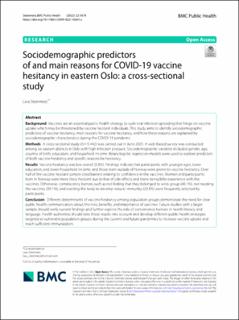| dc.contributor.author | Dora Steinmetz, Lara Maria | |
| dc.date.accessioned | 2023-03-06T10:44:16Z | |
| dc.date.available | 2023-03-06T10:44:16Z | |
| dc.date.created | 2022-10-10T11:18:04Z | |
| dc.date.issued | 2022 | |
| dc.identifier.citation | BMC Public Health. 2022, 22 (1), . | en_US |
| dc.identifier.issn | 1471-2458 | |
| dc.identifier.uri | https://hdl.handle.net/11250/3055991 | |
| dc.description.abstract | Background: Vaccines are an essential public health strategy to curb viral infection spreading that hinge on vaccine uptake which may be threatened by vaccine hesitant individuals. This study aims to identify sociodemographic predictors of vaccine hesitancy, main reasons for vaccine hesitancy, and how these reasons are explained by sociodemographic characteristics during the COVID-19 pandemic. Methods: A cross-sectional study (N = 5 442) was carried out in June 2021. A web-based survey was conducted among six eastern districts in Oslo with high infection pressure. Sociodemographic variables included gender, age, country of birth, education, and household income. Binary logistic regression models were used to explore predictors of both vaccine hesitancy and specific reasons for hesitancy. Results: Vaccine hesitancy was low overall (5.8%). Findings indicate that participants with younger ages, lower education, and lower household income, and those born outside of Norway were prone to vaccine hesitancy. Over half of the vaccine hesitant sample cited barriers relating to confidence in the vaccines. Women and participants born in Norway were more likely hesitant due to fear of side effects and there being little experience with the vaccines. Otherwise, complacency barriers such as not feeling that they belonged to a risk group (46.1%), not needing the vaccines (39.1%), and wanting the body to develop natural immunity (29.3%) were frequently selected by participants. Conclusion: Different determinants of vaccine hesitancy among population groups demonstrate the need for clear public health communication about the risks, benefits, and importance of vaccines. Future studies with a larger sample should verify current findings and further explore the role of convenience barriers in health literacy and language. Health authorities should take these results into account and develop different public health strategies targeted at vulnerable population groups during the current and future pandemics to increase vaccine uptake and reach sufficient immunization | en_US |
| dc.language.iso | eng | en_US |
| dc.publisher | BMC | en_US |
| dc.relation.ispartofseries | BMC Public Health;22, Article number: 1878 (2022) | |
| dc.rights | Navngivelse 4.0 Internasjonal | * |
| dc.rights.uri | http://creativecommons.org/licenses/by/4.0/deed.no | * |
| dc.title | Sociodemographic predictors of and main reasons for COVID-19 vaccine hesitancy in eastern Oslo: a cross-sectional study | en_US |
| dc.type | Peer reviewed | en_US |
| dc.type | Journal article | en_US |
| dc.description.version | publishedVersion | en_US |
| dc.rights.holder | © The Author(s) 2022 | en_US |
| dc.source.articlenumber | 1878 | en_US |
| cristin.ispublished | true | |
| cristin.fulltext | original | |
| cristin.qualitycode | 1 | |
| dc.identifier.doi | https://doi.org/10.1186/s12889-022-14261-y | |
| dc.identifier.cristin | 2059993 | |
| dc.source.journal | BMC Public Health | en_US |
| dc.source.volume | 22 | en_US |
| dc.source.issue | 22 | en_US |
| dc.source.pagenumber | 1-9 | en_US |

